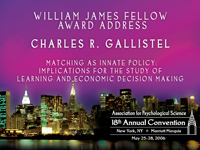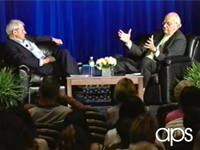When Behavior Met Statistics
David Baker, director of the Archives of the History of American Psychology, began the annual History of Psychology Symposium, “A Sampling of Statistics in the History of American Psychology,” with a personal blast from the past: His former student, Kevin T. Mahoney, was the first speaker.
Mahoney reviewed the agricultural origins of modern statistical sampling and described the central role played by psychologists in the development of early federal statistical programs. An outgrowth of Franklin D. Roosevelt’s New Deal, the “Master Sample” was an attempt by the US Department of Agriculture during the 1940s to find out how farmers felt about new federal agricultural programs. Henry Wallace, then Secretary of Agriculture and founder of the first statistical laboratory in Iowa, brought the USDA and the laboratory together in an effort to come up with a sampling method.
Wallace wanted “to send the fewest people out to talk to the fewest people, and generalize to the largest population,” Mahoney said. The group of early statistics researchers, known as the Division of Programs and Surveys, or DPS, developed a number of ground-breaking techniques that still inform the field of statistical sampling.
One such technique is the “open interview,” conceived by famed psychologist Rensis Likert. The open interview allowed surveyors to gather qualitative information from farmers without constricting them to a narrow range of answers, but was more guided than the rather haphazard open-ended questions that had appeared in earlier interview methods.
The Master Sample also set standards for area sampling, including the use of maps and aerial photographs. The survey eventually reached some 300,000 farms out of 6 million or so then in existence.
Many leaders of early statistics, including Eleanor Maccoby and Leslie Kish, did research for DPS, and Mahoney pointed out “there are direct links to all sorts of different organizations that use the framework of the Master Sample.”
After working for the USDA, Likert used the early survey sampling to establish the Institute for Social Research at the University of Michigan. The institute continues to build on Likert’s pioneering work and remains “devoted to advancing public understanding of human behavior,” said its current director, James S. Jackson.
Jackson, an APS Fellow, called the institute “unique” for its interdisciplinary nature, its ability to perform long-term studies, and the social relevance of its research. The Survey Research Center is the institute’s largest center, specializing in interdisciplinary social science research involving statistical sampling. Other centers include the Center for Political Studies, the Population Studies Center, and the Research Center for Group Dynamics.
The institute’s research areas are vast, ranging from adolescent smoking to the dynamics of poverty. Some of the institute’s studies have run continuously since its formation in the 1940s. One of the most well-known studies is the monthly survey of consumer sentiments.
“It’s the only social science indicator that’s used as a leading economic indicator for the United States,” Jackson said. He said one of the institute’s key challenges is adequately training the next generation of researchers to carry on such important long-range studies.
For Robert Kahn, the theme of the symposium was as much memory as history. As a long-time research scientist at the Survey Research Center, and one of its founders, Kahn was present for many of the memorable moments mentioned by the other speakers. These include the day the center correctly predicted that Harry Truman would defeat Thomas Dewey in the 1948 presidential election, despite Gallup polls and newspaper headlines to the contrary.
Kahn provided an eye-witness perspective, emphasizing the importance of the financial independence of the institute. It is entirely supported by its own grants and contracts, and retains its overhead funds.
“This is a major factor in the success and scientific contribution of the center and the institute,” Kahn said. Elaborating on Jackson’s point about the institute’s interdisciplinary nature, Kahn stressed continuous dialogue between scientists of all backgrounds.
“I think the requirements for creating serious interdisciplinary collaboration are generally misunderstood,” Kahn said. “It will not do to provide for occasional conversations between well-meaning people from different fields.”




APS regularly opens certain online articles for discussion on our website. Effective February 2021, you must be a logged-in APS member to post comments. By posting a comment, you agree to our Community Guidelines and the display of your profile information, including your name and affiliation. Any opinions, findings, conclusions, or recommendations present in article comments are those of the writers and do not necessarily reflect the views of APS or the article’s author. For more information, please see our Community Guidelines.
Please login with your APS account to comment.